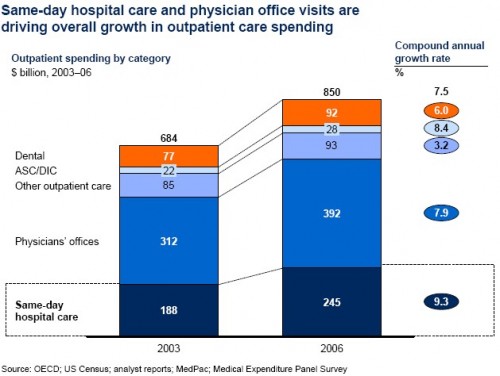As I wrote yesterday, most of the excess health care spending (that above which is predicted by wealth based on other OECD countries) is in outpatient care. It also accounts for the greatest rate of health care cost growth, according to the 2008 analysis by McKinsey & Company. Here it is in graphical form (click to enlarge):
The McKinsey report also tells us what’s driving that growth. The authors break it out into five components, but I think it’s really just four:
- Growth in provider capacity (outpatient care generates big profits, encouraging the provision of more of it),
- Information asymmetry (providers can sell more than is necessary, induce demand),
- Technological innovation (newer means more expensive),
- Price-insensitive patients (out-of-pocket costs are low).
Assuming for the moment those are the main drivers of cost, any approach to reining in cost growth must address them. Thus, broadly speaking, the following is what must be done.
- Restrain capacity. This will happen naturally if margins for outpatient care go down. The following ideas should help.
- Stop paying for volume. Use capitation and quality/cost incentives.
- Evaluate new technology with comparative effectiveness research. Implement value-based insurance designs so consumers pay more out-of-pocket for treatments that are of lower value relative to cost.
- In general, raise out-of-pocket costs but in ways that are sensitive to income and value. That is cost-sharing should be lower for lower income individuals and should be lower for cheaper and more effective treatments (again, value-based insurance design).
None of these ideas are new, and I’m not saying any of them are easy to implement. I’m just saying we’ve identified the problem and solutions exist. Someday we’ll put them together.


